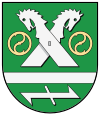Abbensen (Wedemark)
|
Abbensen
Wedemark municipality
|
|
|---|---|
| Coordinates: 52 ° 34 ′ 7 ″ N , 9 ° 36 ′ 48 ″ E | |
| Height : | 50 m above sea level NHN |
| Area : | 10.9 km² |
| Residents : | 1041 (December 31, 2015) |
| Population density : | 96 inhabitants / km² |
| Incorporation : | March 1, 1974 |
| Postal code : | 30900 |
| Area code : | 05072 |
|
Location of Abbensen in Wedemark
|
|
|
John's Chapel from 1912
|
|
Abbensen is a district of the municipality of Wedemark in Lower Saxony in the Hanover region and is located in the northwestern part of the municipality on the border with Neustadt am Rübenberge .
history
Abbensen was first mentioned in 1287 as "Abbenhusen". As early as 1202, the 'Obermühle', a water mill powered by the 'Jürse', was a landmark on the trade route to Hanover. It was dismantled around 1825 because the more sparsely flowing Jürse water as a result of drainage could no longer drive the mill wheel. Until 1852 ( customs union ) there was a customs post here, as indicated by the street name "Alte Zollstrasse".
On March 1, 1974 Abbensen was incorporated into the new municipality of Wedemark.
politics
Local council
The local council is jointly responsible for the districts of Abbensen, Duden-Rodenbostel and Negenborn and consists of three councilors and four councilors from the following parties:
(Status: local election September 11, 2016)
Local mayor
The local mayor is Peter Reuter (SPD), he is represented by Wolfgang Kasten (CDU).
coat of arms
The draft emblem of Abbensen comes from the in Isernhagen born and later in Hannover living heraldry and crest painter peoples Gustav , who is also the emblem of Großburgwedel , Melle village , Wunstorf has designed and many other towns. The approval of the coat of arms was granted by the district president in Lüneburg on November 26, 1963.
| Blazon : "In green a silver bar , above two crossed, silver horse heads ( wind boards ), in each of the side corners of which a golden ring with two fish bubbles floats, below a lying, silver wolf tang ." | |
| Justification for the coat of arms: The two horse heads (wind boards) symbolize the still rural character of the village. The two rings with the fish bubbles point to the frieze of the valuable winged altar of the chapel from around 1450. The silver crossbar is reminiscent of the customs station that existed in Abbensen on the border of the former principalities of Lüneburg and Calenberg . The Wolfsangel underlines the affiliation to the Burgdorf district . |
Culture and sights
Buildings
- About 500 meters south of the former watermill site are the ruins of the Erdholländer windmill built in 1825. Both of the post mills that were previously at this point (first mentioned in 1557) were destroyed by fire (1769 and around 1790). (J. G.)
- The valuable altar cabinet (approx. 1500) of the St. John's Chapel, built in 1912, achieved some fame and was taken over by the dilapidated first Abbens chapel from 1665.
Architectural monuments
Photo gallery
Web links
Individual evidence
- ↑ Area information for the municipality of Wedemark. (PDF; 10 kB) In: Website of the municipality of Wedemark. January 1, 2011, accessed May 6, 2019 .
- ↑ Population of the community Wedemark. (PDF; 121 kB; p. 2) In: Website of the municipality of Wedemark. December 31, 2015, accessed May 6, 2019 .
- ^ Federal Statistical Office (ed.): Historical municipality directory for the Federal Republic of Germany. Name, border and key number changes in municipalities, counties and administrative districts from May 27, 1970 to December 31, 1982 . W. Kohlhammer, Stuttgart / Mainz 1983, ISBN 3-17-003263-1 , p. 221 .
- ↑ a b Local council of Abbensen, Duden-Rodenbostel and Negenborn. In: Website of the municipality of Wedemark - localities Abbensen, Duden-Rodenbostel and Negenborn. Retrieved July 20, 2017.
- ^ A b Landkreis Hannover (ed.): Wappenbuch Landkreis Hannover . Self-published, Hanover 1985, p. 474-475 .







